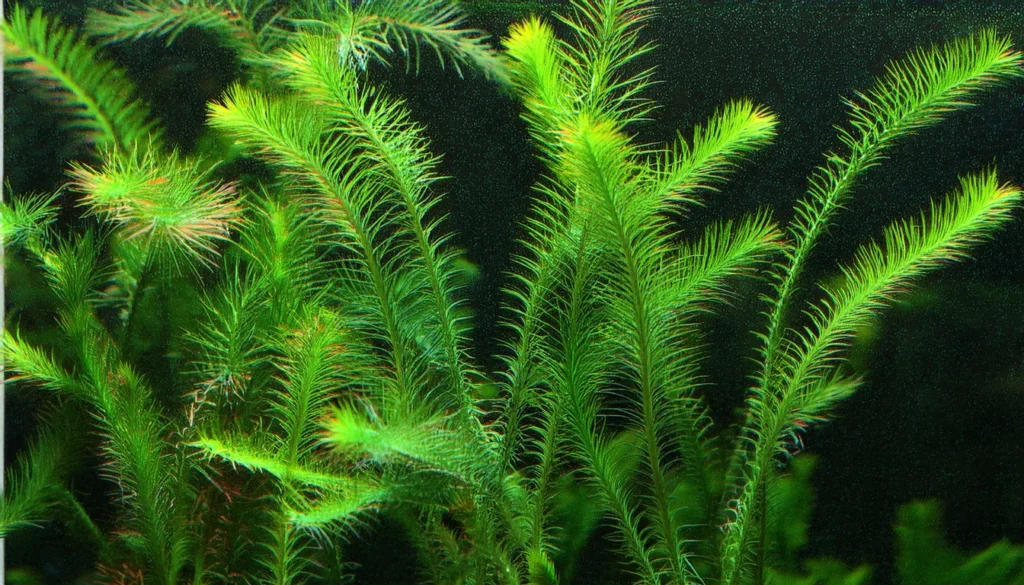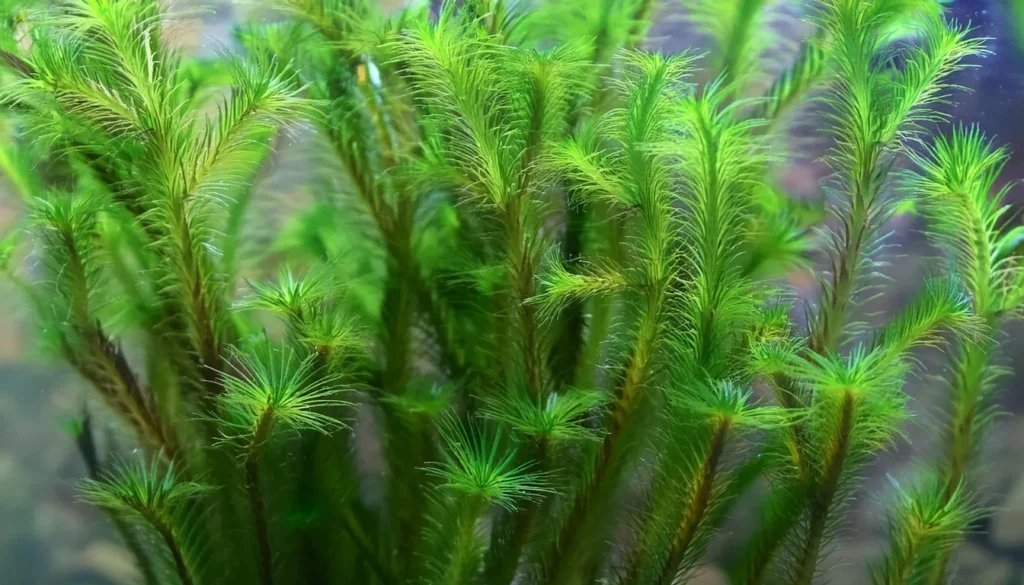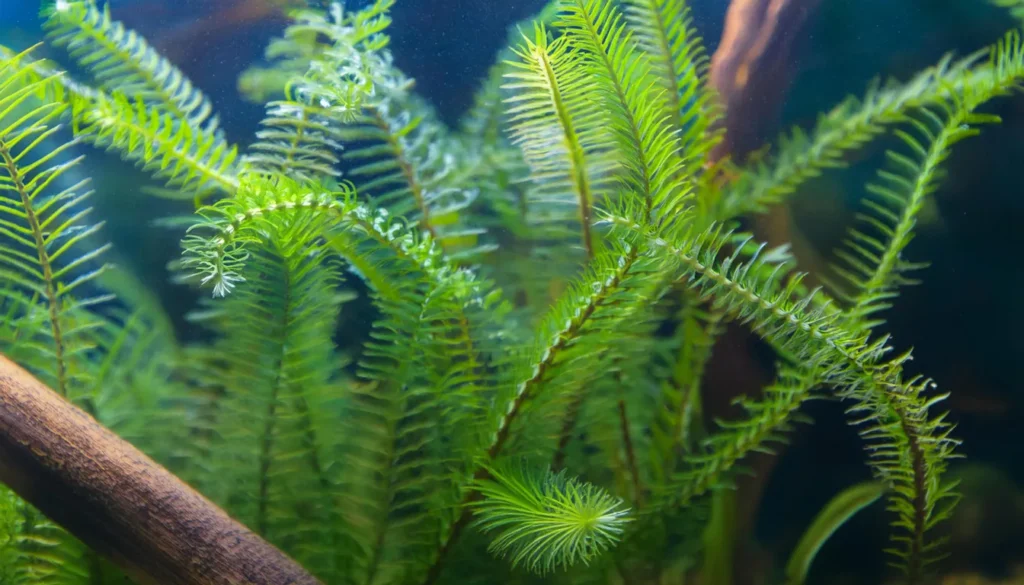Welcome to our latest blog post, where we’ll dive into the captivating world of aquatic plants. Today, we’re focusing on the mesmerizing Mayaca fluviatilis, a freshwater aquarium plant that truly shines with elegance and grace.
Whether you’re a seasoned aquarium enthusiast or just starting out, Mayaca fluviatilis is a must-have addition to your underwater oasis.

Key Takeaway
- Mayaca fluviatilis is a stunning aquatic plant that enhances the beauty of freshwater aquariums.
- Its slender stems and delicate foliage add elegance to any aquascape.
- Mayaca fluviatilis is perfect for both beginners and experienced aquarists.
- Proper care and maintenance are essential for the health and vitality of this beautiful plant.
- Integrating Mayaca fluviatilis into your aquarium design can create visually striking underwater landscapes.
Quick Stats
| Attribute | Details |
| Family Name | Mayacaceae |
| Origin | Widely distributed in Central and South America, as well as parts of North America |
| Height | 30-50 cm (12-20 inches) |
| pH Range | 6.0 – 7.5 |
| CO2 Requirement | Low to Moderate |
| Growth Rate | Moderate |
| Care Level | Moderate |
| Color Form | Bright to Olive Green |
| Water Conditions | 22-28°C (72-82°F), soft to moderately hard water |
| Max Size | Can grow up to 50 cm (20 inches) tall, often trimmed shorter in aquariums |
| Lighting | Moderate to High |
| Supplements | Benefits from CO2 supplementation and liquid fertilizers |
| Placement | Mid-ground to Background |
| Propagation | Stem cuttings |
What Is Mayaca Fluviatilis?
Mayaca fluviatilis, also known as “water primrose,” is a submerged plant species native to the southeastern United States, particularly Florida. It is a slender and delicate plant that thrives in warm, tropical climates and prefers soft, slightly acidic water conditions.
With its graceful appearance, Mayaca fluviatilis adds a touch of elegance to any aquatic environment.
Native Habitats And Geographical Distribution
Mayaca fluviatilis can be found in various freshwater habitats, including streams, rivers, lakes, and swamps. It is commonly found in the southeastern region of the United States, where it is native.
The plant’s ability to adapt to different aquatic ecosystems contributes to its widespread geographical distribution within its native range.
RELATED: A Splash Of Color With Alternanthera Variegatus For Your Aquatic Garden
Physical Characteristics
- Stems: The plant features slender, wiry stems that can grow to varying lengths, typically ranging from 10 to 30 centimeters (4 to 12 inches) tall. The stems are often reddish or green in color, depending on environmental conditions and nutrient availability.
- Leaves: The leaves of Mayaca fluviatilis are small, narrow, and lanceolate (lance-shaped), with a pointed tip. They grow in whorls around the stems, typically comprising four to eight leaves per whorl. The leaves are arranged alternately along the stem and may exhibit a vibrant green coloration.
- Texture: The foliage of Mayaca fluviatilis has a fine and feathery texture, adding a delicate and graceful appearance to the aquarium or pond. The leaves are relatively soft and flexible, with a slight translucency that allows them to filter and diffuse light effectively.
- Growth Habit: Mayaca fluviatilis has an upright growth habit, with stems branching out from the base and forming dense clusters or mats in favorable conditions. The plant tends to grow vertically towards the water surface, but it can also spread horizontally along the substrate or water surface.

Lighting Needs
- Intensity: Aim for moderate to high-intensity lighting, with approximately 2 to 3 watts per gallon of full-spectrum aquarium LED or fluorescent lighting. Adjust the lighting intensity based on the specific requirements of your setup and the growth rate of the plants.
- Duration: Provide a photoperiod of 8 to 10 hours of light per day. This mimics natural daylight cycles and allows the plants to undergo photosynthesis effectively while providing them with a period of rest during the dark hours.
- Consistency: Maintain consistent lighting schedules to prevent fluctuations in light exposure, which can disrupt plant growth patterns and lead to stress or algae issues. Use a timer to automate the lighting schedule and ensure consistent light levels each day.
- Quality: Ensure that the lighting spectrum includes both blue and red wavelengths, as these are crucial for supporting photosynthesis and promoting healthy plant growth. Full-spectrum lighting fixtures designed for planted aquariums or aquatic plants are ideal for providing the necessary light spectrum.
Temperature Parameter
- Temperature Range: Maintain water temperatures within the range of 20°C to 28°C (68°F to 82°F) for optimal growth of Mayaca fluviatilis.
- Optimal Temperature: Aim for a temperature around 24°C to 26°C (75°F to 79°F), which is considered ideal for most tropical aquarium plants, including Mayaca fluviatilis.
- Consistency: Ensure that the water temperature remains stable within the preferred range to avoid temperature fluctuations, which can stress the plants and affect their growth.
- Heating and Cooling: Use aquarium heaters to regulate water temperature in cooler environments, especially during colder months. Conversely, employ aquarium chillers or fans to prevent overheating in warmer climates or during hot weather.
Optimal Water Condition
- pH Level: Aim for a slightly acidic to neutral pH level between 6.5 and 7.5. Mayaca fluviatilis can tolerate a slightly broader pH range, but maintaining it within this range helps ensure optimal nutrient availability and overall health.
- Water Hardness (GH): Mayaca fluviatilis prefers moderately soft to moderately hard water with a general hardness (GH) level between 2 to 10 dGH (degree of general hardness).
- Carbon Dioxide (CO2): Provide moderate levels of carbon dioxide (CO2) supplementation, ideally in the range of 20 to 30 ppm (parts per million), to support healthy photosynthesis and robust growth. CO2 supplementation can enhance plant growth and coloration.
- Nutrient Levels: Ensure adequate levels of essential nutrients, including nitrogen (N), phosphorus (P), potassium (K), iron (Fe), and micronutrients. You can achieve this through regular water changes, the use of liquid fertilizers, or root tabs.

Substrate Requirement
- Fine-grained Substrate: Opt for a fine-grained substrate like aquarium sand or fine gravel. This type of substrate allows the plant’s delicate roots to anchor securely while still providing ample access to nutrients and water.
- Nutrient-rich Substrate: Consider using a nutrient-rich substrate specifically formulated for planted aquariums. These substrates often contain essential nutrients and minerals that promote healthy plant growth. Alternatively, you can supplement the substrate with root tabs or fertilizer pellets to ensure sufficient nutrient availability.
- Depth: Aim for a substrate depth of at least 2 to 3 inches (5 to 7.5 cm) to accommodate the plant’s root system and provide stability for the stems. A deeper substrate layer allows room for root expansion and promotes nutrient absorption.
Placement Options
- Foreground Planting: Plant Mayaca fluviatilis in the foreground of the aquarium to create a lush carpeting effect. Arrange the stems in clusters or rows along the front edge of the tank to frame the substrate and add visual interest to the lower portion of the aquascape.
- Midground Accent: Use Mayaca fluviatilis as a midground accent plant to add depth and dimension to the aquarium layout. Position the stems behind other foreground plants or hardscape elements, such as rocks or driftwood, to create a layered effect and draw the viewer’s eye toward the center of the tank.
- Background Filler: Place Mayaca fluviatilis in the background of the aquarium to serve as a backdrop for larger or taller plants. Plant the stems in groups or clusters along the back glass of the tank to create a dense, textured background that enhances the overall depth and density of the aquascape.
Recommended Tank Size
- Nano Tanks (5 to 10 gallons): Suitable for small-scale aquascapes or nano tanks where space is limited. Mayaca fluviatilis can be planted in the foreground or midground to create a lush carpeting effect or as a background filler in smaller setups.
- Medium Tanks (20 to 50 gallons): Ideal for medium-sized aquariums where Mayaca fluviatilis can be planted as a midground or background plant. This size allows for more flexibility in aquascape design and provides ample space for the plant to grow and flourish.
- Large Tanks (50 gallons and above): Recommended for larger aquariums or planted tanks where Mayaca fluviatilis can be used as a background filler or as part of a densely planted aquascape. Larger tanks offer plenty of room for the plant to spread and create a visually stunning display.
Suitable Tank Size
- Nano Tanks (5 to 10 gallons): Suitable for small-scale aquascapes or nano tanks where space is limited. Mayaca fluviatilis can be planted in the foreground or midground to create a lush carpeting effect or as a background filler in smaller setups.
- Medium Tanks (20 to 50 gallons): Ideal for medium-sized aquariums where Mayaca fluviatilis can be used as a midground or background plant. This size allows for more flexibility in aquascape design and provides ample space for the plant to grow and flourish.
- Large Tanks (50 gallons and above): Recommended for larger aquariums or planted tanks where Mayaca fluviatilis can be utilized as a background filler or as part of a densely planted aquascape. Larger tanks offer plenty of room for the plant to spread and create a visually stunning display.

Suitable Tank Mates
- Small to Medium-sized Fish: Fish species such as tetras, rasboras, danios, guppies, and smaller cichlids like dwarf cichlids can make suitable tank mates. Avoid large or aggressive fish that may uproot or damage the delicate stems of the plant.
- Shrimp and Snails: Invertebrates like cherry shrimp, amano shrimp, and nerite snails can be excellent tank mates for Mayaca fluviatilis. They help with algae control and do not pose a threat to the plant.
- Bottom Dwellers: Peaceful bottom-dwelling species such as Corydoras catfish and small loaches can complement Mayaca fluviatilis. These fish help to clean up the substrate without disturbing the plant.
Nutritional Needs Of The Plant
Mayaca fluviatilis primarily absorbs nutrients from the water column through its leaves and stems. While it does not have extensive root systems like some other aquatic plants, it still requires essential nutrients for healthy growth. Here are the key nutritional needs of Mayaca fluviatilis:
- Macronutrients: These are the primary nutrients required in relatively large quantities:
- Nitrogen (N): Essential for leaf and stem growth, nitrogen is a key component of chlorophyll, the pigment responsible for photosynthesis.
- Phosphorus (P): Important for energy transfer within the plant and for the development of roots and flowers.
- Potassium (K): Aids in photosynthesis, water regulation, and overall plant health.
- Micronutrients: These are trace elements that are equally important for plant health, albeit needed in smaller quantities. Micronutrients include iron (Fe), manganese (Mn), zinc (Zn), copper (Cu), boron (B), molybdenum (Mo), and chlorine (Cl). These nutrients play vital roles in enzyme function, chlorophyll synthesis, and various metabolic processes within the plant.
- Carbon (CO2): Carbon dioxide is a critical component of photosynthesis, where it is converted into sugars to fuel plant growth. In planted aquariums, CO2 supplementation may be necessary, especially in densely planted setups or high-light environments.

Mayaca Fluviatilis Cultivation Tips
- CO2 and Nutrients: While not always necessary, supplementing carbon dioxide (CO2) can enhance growth and coloration. Ensure a balanced nutrient supply by using liquid fertilizers or root tabs to provide essential macro and micronutrients.
- Substrate: Mayaca fluviatilis can thrive in a nutrient-rich substrate like aquasoil or nutrient-rich gravel. A nutrient-rich substrate promotes healthy root development and supports vigorous growth.
- Pruning and Maintenance: Trim Mayaca fluviatilis regularly to prevent overgrowth and maintain its desired shape. Remove any dead or decaying leaves to prevent nutrient imbalances and maintain water quality.
- Water Flow: Provide gentle to moderate water circulation to prevent debris buildup and promote nutrient distribution. Avoid strong currents that may uproot or damage the delicate stems of the plant.
RELATED: Eleocharis Pusilla Guide For Proper Care, Tips & Growth
Plant Propagation Tips
- Trimming: Use sharp, clean scissors to trim healthy stems of Mayaca fluviatilis. Choose stems that are at least 3-4 inches long and have multiple nodes (where leaves attach) along the length.
- Preparation: Before planting, remove any leaves from the lower portion of the stem that will be buried in the substrate. This helps to prevent rotting and promotes better root growth.
- Planting: Plant the trimmed stems into the substrate, ensuring that at least one node is buried securely. Planting in groups or clusters can create a denser appearance and a more natural look in the aquarium.
- Rooting: Mayaca fluviatilis typically develops roots from the buried nodes. Ensure that the substrate is nutrient-rich and provides good anchorage for the stems. Root tabs or a nutrient-rich substrate can help promote healthy root growth.
Benefits Of Planting Mayaca Fluviatilis
- In addition to its aesthetic value, Mayaca fluviatilis provides numerous benefits to aquatic ecosystems. As a natural habitat, it offers shelter and protection for fish and invertebrates, contributing to the overall biodiversity of the aquarium.
- Furthermore, Mayaca fluviatilis serves as a food source for herbivorous fish, adding nutritional value to their diet. This helps maintain a balanced and healthy ecosystem within the aquarium, promoting the well-being of all its inhabitants.
- Mayaca fluviatilis plays a vital role in maintaining water quality and clarity. As an aquatic plant, it absorbs excess nutrients, such as nitrates and phosphates, from the water through its roots and leaves. This process helps prevent the buildup of harmful substances and reduces the risk of water pollution.
- By absorbing these nutrients, Mayaca fluviatilis also helps control algae growth, preventing the development of unsightly and potentially harmful blooms. Additionally, the presence of this plant can enhance water clarity, creating a crystal-clear and visually appealing aquarium.

Identifying And Addressing Common Pests And Diseases Affecting Mayaca Fluviatilis
- Snail infestations: Look for small snails on the plant’s leaves or substrate. Remove them manually or use snail-trapping techniques to control their population.
- Algae growth: Algae can compete with Mayaca fluviatilis for nutrients and light. To control algae growth, maintain a proper light cycle, manage nutrient levels, and consider introducing algae-eating species like shrimp or fish.
- Fungal infections: Monitor the plant for signs of rot, discoloration, or slimy patches. If fungal infections are present, remove affected leaves or trim infected parts of the plant. Use appropriate anti-fungal treatments if necessary.

Conclusion
Mayaca fluviatilis is a remarkable freshwater aquarium plant that effortlessly adds elegance and beauty to any aquascape.
With its slender stems and delicate foliage, this aquatic plant creates a visually stunning backdrop, enhancing the overall aesthetics of your underwater world.
You can fully enjoy and appreciate the captivating allure of Mayaca fluviatilis in your aquarium by providing the proper care and maintenance.
Whether you’re just starting as a beginner or have years of experience as an experienced hobbyist, incorporating Mayaca fluviatilis into your aquarium design will elevate its visual appeal and create a captivating aquatic landscape.
Its graceful presence and vibrant green color will bring life and vibrancy to your aquascape, providing an enriching environment for your fish and yourself.
Remember, with the right lighting, water conditions, and regular pruning, Mayaca fluviatilis will thrive and continue to captivate you with its beauty.
As you embark on your aquascaping journey, consider placing Mayaca fluviatilis as a key element in your design, allowing it to showcase its natural elegance and create a serene and captivating underwater oasis.
RELATED: Unraveling The Helanthium Vesuvius Spirals Of Aquatic Beauty
Frequently Asked Questions
What Are The Native Habitats And Geographical Distribution Of Mayaca Fluviatilis?
Mayaca Fluviatilis is native to the southeastern United States, particularly Florida. It can be found in various freshwater habitats such as streams, rivers, lakes, and swamps.
How Do I Integrate Mayaca Fluviatilis Into My Aquarium Design?
Mayaca Fluviatilis can be used for lush backgrounds, midground clusters, or foreground accents in your aquarium. It can be paired with companion plants like Anubias, Java fern, or Cryptocoryne for enhanced visual appeal. It is also compatible with different aquascaping styles, such as Dutch, nature, or biotope aquascapes.
How Do I Prune And Maintain Mayaca Fluviatilis?
Regular pruning helps control the growth and density of Mayaca Fluviatilis. Trim the stems close to the substrate to encourage new growth. Routine maintenance, such as water changes, nutrient supplementation, and algae control, is also essential for its health and vitality.
What Are Common Issues And Troubleshooting Tips For Mayaca Fluviatilis?
Common issues include pest infestations and diseases. Monitor the plant for signs of pests like snails, algae, or fungal infections and take appropriate measures to address them. Maintaining optimal growth conditions, such as proper lighting, water parameters, and nutrient levels, will help prevent potential problems.
What Are Sustainable Cultivation Practices For Mayaca Fluviatilis?
To contribute to sustainability, source plants from reputable suppliers, avoid collecting them from the wild, and practice responsible propagation and sharing within the hobby. Additionally, conserve water and energy and maintain proper care practices to support the overall sustainability of Mayaca Fluviatilis and the aquatic ecosystem.
- Unveiling The Wonders Of Riccia Fluitans In Aquascapes - August 7, 2024
- Vallisneria Gigantea Var. Guide To Care And Cultivation At Home - July 31, 2024
- Vesicularia Dubyana Care & Growth Guide Tips For Beginner Gardeners - July 30, 2024
